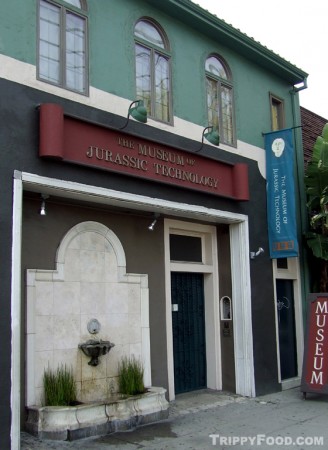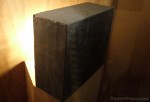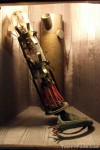Museum of Jurassic Technology
Culver City, California
It’s not a museum depicting how CGI was used to bring Michael Crichton’s novel to life; there is no reproduction of tools used by ceratosaurus, allosaurus and other prehistoric life. So what is it, exactly? Well, imagine a committee was formed to open a repository of knowledge in display format, and that this committee featured Rube Goldberg, Albert Einstein, P.T. Barnum, John Waters, L. Ron Hubbard, Robert LeRoy Ripley, Leonardo DiVinci, Baron Victor Frankenstein and Professor Irwin Corey. If you find that concept confusing, then you have head start on what’s to come with a trip to the MJT. Part of their mission statement is to “provide[s] the academic community with a specialized repository of relics and artifacts from the Lower Jurassic”, which technically was between 200 and 175 million years ago. Understanding this as you enter will put you in a better frame of mind to truly appreciate the museum. Suspension of disbelief is not required; disregard for disbelief is. Your visit to the museum will only work if you don’t wonder or even care what is true and what is false, but simply be entertained by what are literally thought-provoking and imaginative displays of curiosities. Like some bizarre closet of secrets, the museum features displays of everything from the importance and significance of cat’s cradles as language to early theater techniques for reproducing weather conditions onstage. Once you’ve rung the bell at the front to gain entrance to the windowless structure, you enter a dark and mysterious labyrinth; the narrow hallways join rooms that make a corn maze seem easy to navigate. The darkness allows the displays to be creatively lit using micro-spotlights, with some exhibits creating their own light. In some places, 3-D and holographic technology is used to have things appear in the display when looking through special lenses. Names and titles sound grand and familiar, but Google searches will leave you scratching your head.
At the front of the museum are the permanent collections. These include captive specimens of the stink ant of the Cameroon; a horn projection that grew from the head of Mary Davis; displays regarding the life of neurophysicist Geoffrey Sonnabend, and my favorite – the tale of the search and capture of the elusive Deprong Mori. I won’t give too much away regarding the latter, except to say that the Deprong Mori (or “piercing devil”) is a tiny bat that has evolved a rather unusual talent; I guarantee that you will walk away from this exhibit with either an ear-to-ear grin or the desire to cause mayhem. As the rooms spread out, you will feel like you’ve entered a fourth dimension – it seems like the museum expands while you’re inside it, with one room opening into another until you feel like you’ve left the city limits. Since it is impossible to separate fact from fallacy, your best bet is to give in and let go. One fascinating display featured the micromosaics of British physician Henry Dalton. While the actual existence of Henry Dalton may be in question, the art created in his name is very real. Dalton, it would seem, would meticulously remove the shimmering, colorful scales from the wings of various species of butterflies, and then painstakingly arrange them in glittering mosaic images that under the microscope are absolutely breathtaking. Also of note are the microminiature sculptures of Hagop Sandaldjian, so tiny that they can only be seen in detail through a microscope and could fit in the eye of a needle. Other displays defy explanation; in fact, some have no explanation and are left to the interpretation of the beholder. Temporary collections are equally as unique, mysterious and befuddling – Garden of Eden On Wheels feature various tiny dioramas depicting life in L.A.’s trailer parks throughout the years, along with photographs and artifacts recovered from some of the older parks. Rotten Luck includes a variety of old and decaying dice from the collection of Ricky Jay.
A newer second floor features a gallery with paintings of dogs, not playing poker but who were active participants in the Russian space program and were some of the first living things in space. The gallery looks like a wealthy pet owner’s sitting room, but when you learn the names and read the stories of these space mutts, you begin to have a connection to the subject matter not unlike wondering what the Mona Lisa was really like. The aforementioned cat’s cradle exhibit seems a bit out of place, but moving holograms of hands creating the string figures superimposed over the displays are fun to look at. One room is devoted to a logic notation system created by Shea Zellweger, PhD that combines mathematics, logic and an alphabet into a confusing structure that only a PhD could understand. At the back of the second floor is the newest addition, the Tula Tea Room (modeled after the study of Tsar Nicolas II in St Petersburg). The hostess will graciously pour you a fresh cup of hot, black tea, and a lavishly decorative tray offers self-serve cookies to go with it. Although the cookies were obviously of the type found in garden-variety grocery stores, it was still nice to take a break in the only room in the building with windows while staring at the lounging Russian wolfhound perched on one of the benches.
There is a saying that if you can’t dazzle them with brilliance, baffle them with bullshit; The Museum of Jurassic Technology effectively does both in a pseudo-serious yet tongue-in-cheek manner. The museum’s small exterior makes it easy to miss, but just remember that it’s on Venice Boulevard close to the intersection of The Twilight Zone.
Museum of Jurassic Technology
9341 Venice Boulevard
Culver City, CA 90232-2621
GPS coordinates: 34°1’32.72″N 118°23’42.02″W
See images of Val’s visit to the Museum of Jurassic Technology




